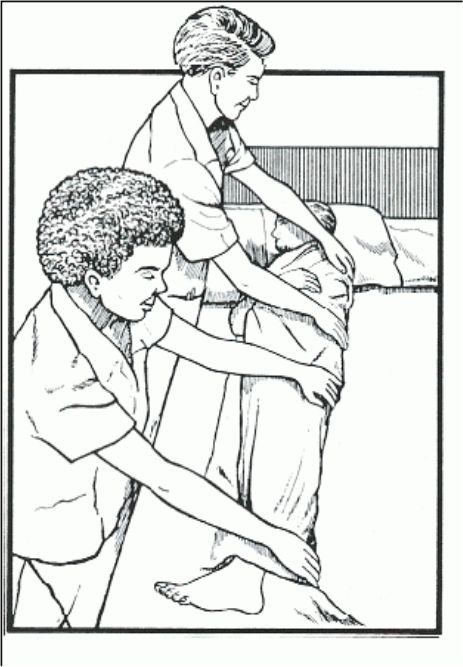 This is the Archived Desktop Edition. You should be transferred to the Newest Edition for Desktop and Mobile within 2 seconds. |
||||
Lesson 4: Body Mechanics |
||||
|
SECTION II. Positioning and Ambulating the Adult Patient 4-8. INTRODUCTION One of the basic procedures that nursing personnel perform most frequently is that of changing the patient's position. Any position, even the most comfortable one, will become unbearable after a period of time. Whereas the healthy person has the ability to move at will, the sick person's movements may be limited by disease, injury, or helplessness. It is often the responsibility of the practical nurse to position the patient and change his position frequently. Once the patient is able to ambulate, certain precautions must be taken to ensure the patient's safety. 4-9. REASONS FOR CHANGING THE POSITION OF A PATIENT The following are reasons for changing a patient's position.
4-10. BASIC PRINCIPLES IN POSITIONING OF PATIENTS
4-11. TURNING THE ADULT PATIENT a. General Principles for Turning the Adult Patient. Sometimes the physician will specify how often to turn a patient. A schedule can be set up for turning the adult patient throughout his "awake" hours. The patient should be rotated through four positions (unless a particular position is contraindicated):
Plan a schedule and follow it. Record the position change each time to ensure that all positions are used. One example of a schedule for turning would be:
Notice that in the preceding sequence, the patient is required to make only a quarter turn rather than a half turn each time the position is changed. If the patient experiences pain while turning, a quarter turn will be less painful than a half turn. Certain conditions may make it impossible to turn the patient. Turning may be impossible if the patient has fractures that require traction appliances. Turning may be harmful to patients with spinal injuries. In these cases, you need to rub the back by lifting the patient slightly off the bed and massaging with your hand held flat. It is especially important to prevent skin breakdowns in the person who lies on his back for long periods of time. NOTE : For the initial development of skin breakdown, a patient does not have to lie on his back for long periods of time, especially if moisture and sheet wrinkles are present.You may want to turn a patient only to wash or rub the back or change the bed. Logrolling (see figure 4-4). Description.
Technique.
4-12. MAINTAINING PROPER BODY ALIGNMENT WITH THE PATIENT ON HIS BACK Patients who must lie on their backs much of the time should be kept as comfortable as possible to prevent body deformities. The paraplegic and quadriplegic may not be able to tell you if their position is uncomfortable. You must be especially attentive in this case to prevent possible problems from malalignment. Pillows can be used to support the patient's head, neck, arms, and hands and a footboard used to support the feet.
If the patient's trunk must lie flatter than the neck and head:
The Brookside Associates Medical Education Division is dedicated to the development and dissemination of medical information that may be useful to medical professionals and those in training to become medical professionals. This website is privately-held and not connected to any governmental agency. The views expressed here are those of the authors, and unless otherwise noted, do not necessarily reflect the views of the Brookside Associates, Ltd., any governmental or private organizations. All writings, discussions, and publications on this website are unclassified. © 2007 Medical Education Division, Brookside Associates, Ltd. All rights reserved
|
|
|||



